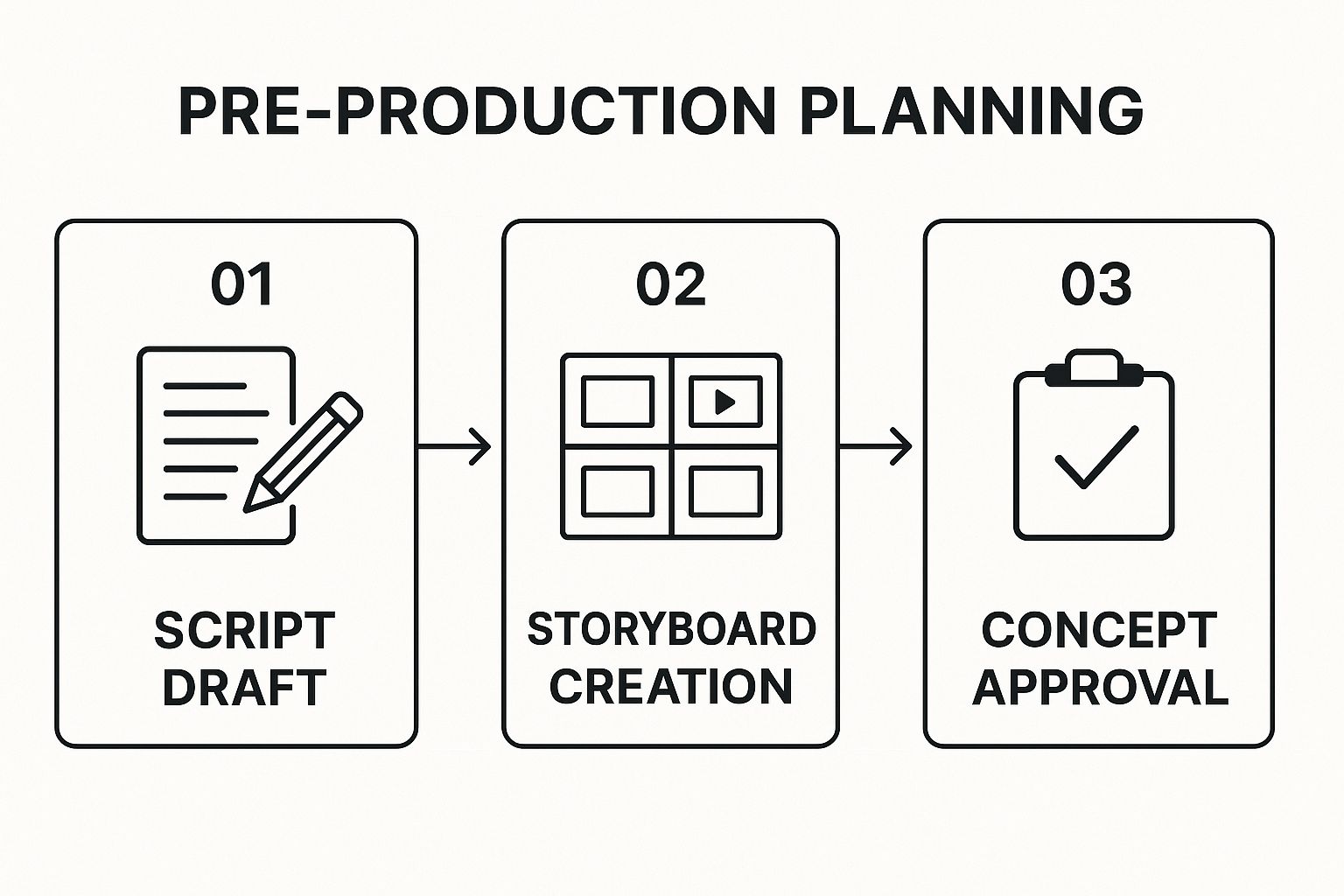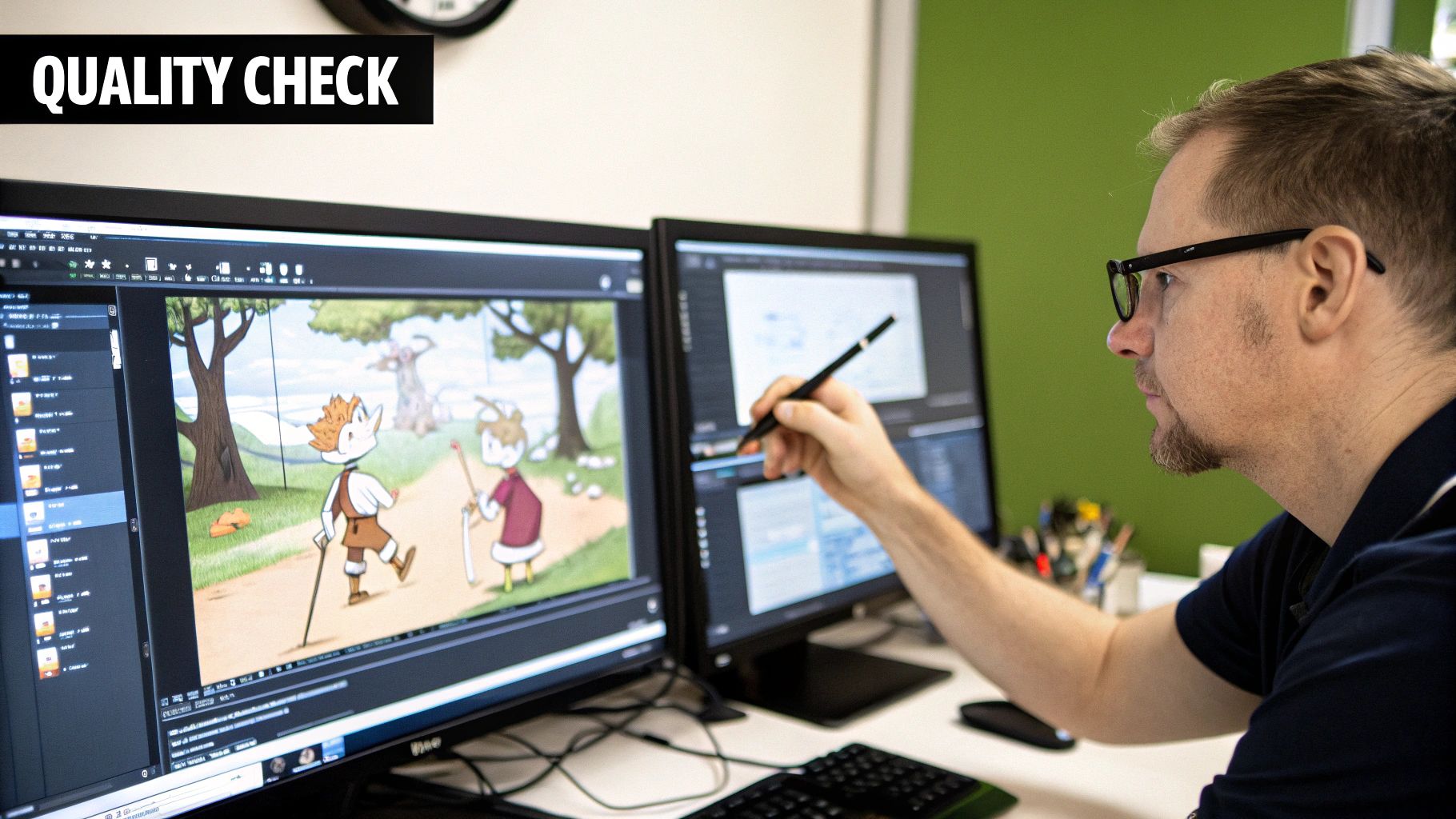Animation production management is all about taking a creative project from a spark of an idea to the final screen. It’s the art and science of planning, scheduling, and wrangling every single piece of the puzzle—from pre-production and production to post-production—to get a stellar animation out the door, on time and on budget.
The Framework of Successful Animation Management
Think of effective animation management as the backbone of any project, whether it’s a quick 30-second commercial or a sprawling feature film. It's the essential structure that allows creativity to actually happen without everything spiraling into chaos. This process turns a simple concept into a polished final product by breaking it down into clear, manageable stages, each with its own goals.
Without this solid framework? Timelines slip, budgets balloon, and the creative vision gets lost in the noise.
And let's be real, the demand for animated content is exploding. The global animation market is set to jump from around $394 billion in 2025 to over $562 billion by 2032, thanks in large part to streaming platforms and new tech. This means studios absolutely need efficient workflows to keep up.
The Three Foundational Phases
At its heart, animation management is built on three distinct but deeply connected phases: pre-production, production, and post-production.
A great way to think about it is like building a house. Pre-production is the blueprint, production is the actual construction, and post-production is all the interior design and finishing touches. Each stage builds directly on the last one. If you rush the blueprint, the construction phase will be a nightmare. It’s that simple.
To give you a better idea of how these stages flow together, here’s a simple table breaking them down.
| Phase | Primary Goal | Key Deliverables |
|---|---|---|
| Pre-production | Plan everything. Solidify the concept, story, and visual style. | Script, Storyboard, Animatics, Concept Art, Character Designs |
| Production | Create the actual animated scenes based on the plan. | Layout, Modeling, Texturing, Rigging, Animation, Lighting |
| Post-production | Polish the created assets and assemble the final product. | Compositing, Visual Effects (VFX), Sound Design, Editing, Color Grading |
Each phase has its own rhythm and requires a different focus, but they all need to work in harmony for the project to succeed.
This visual shows just how crucial those early pre-production tasks are for setting up a solid foundation.

As you can see, you can't really start a solid storyboard without a locked-in script. And you certainly don't want to move forward until that storyboard is approved. One step flows directly into the next.
Balancing Creativity with Logistics
One of the toughest—and most important—parts of managing an animation project is striking the right balance between the team's artistic vision and the real-world logistical constraints. This is so much more than just ticking off tasks on a checklist; it requires a genuine understanding of the creative process itself. For a closer look at planning and resource allocation, digging into the principles of mastering workforce capacity planning is a great next step.
The best production managers create an environment where artists can do their best work. They are translators, turning the logistical needs of a schedule into a clear, actionable plan that supports creative goals instead of stifling them.
This balancing act is a huge part of a much bigger strategy. To see how these ideas play out across different creative fields, take a look at our guide on creative operations management.
Steering Pre-Production for a Strong Start

Let’s be honest: an animation project’s success is often decided long before a single frame gets rendered. The pre-production phase isn't just a warm-up; it's where the entire foundation is poured.
If you rush this part, you're pretty much guaranteeing problems down the road. I'm talking budget overruns, missed deadlines, and a final product that feels… off. A solid plan here is your best insurance policy.
This is where effective animation production management really shines. It's about turning a cool idea into a concrete, actionable blueprint. That journey starts by locking down the script and then bringing it to life visually with storyboards. These aren't just pretty sketches—they’re the first real gut check for your pacing, composition, and storytelling.
From Storyboard to Animatic
Once everyone signs off on the storyboards, you stitch them together into an animatic. Think of it as a rough draft of your film, a moving storyboard set to scratch audio and temporary dialogue. This is the first time you can feel the project's heartbeat and get a real sense of the rhythm and flow of each scene.
I remember working on a 2D series where the production manager used the animatic to forecast animation hours for every single scene. It was a game-changer. A seemingly simple 10-second shot was revealed to be packed with complex character interactions, flagging it as a potential bottleneck weeks before the animation team even touched it.
That simple insight allowed us to shift resources around early and avoid a major delay. That's the power of a good animatic.
A detailed animatic is more than a creative tool; it’s a project management goldmine. It lets you build schedules and budgets grounded in reality, not just wishful thinking.
This early planning stage is a unique mix of creative vision and hardcore strategic thinking. A lot of these principles aren't just for animation, by the way. You can dig deeper into these strategies in our guide on project management for creatives.
Building the Production Bible
Everything you create and decide on during pre-production—character model sheets, color palettes, background designs, you name it—gets compiled into what's called a production bible. This document is the single source of truth for the entire team. No exceptions.
Think of it like this:
- For artists: It’s a clear visual guide that keeps everything consistent across hundreds of shots.
- For animators: It details specific character expressions and key poses they need to hit.
- For managers: It’s the ultimate reference to ensure every department is aligned with the creative vision.
Without a detailed bible, you're just inviting chaos. A character’s shirt might change color mid-scene. A background element might be built to the wrong scale. Solid animation production management means this bible is thorough, easy to access, and treated as the final word. It's the creative contract that keeps everyone on the same page.
Executing Production with Precision and Focus
Alright, the pre-production groundwork is solid. Now for the fun part. This is where your animation truly springs to life—where all that planning becomes pixels on a screen.
The production phase is an absolute whirlwind of creativity. We're talking 3D modeling, texturing, rigging, and finally, animating the scenes that will tell your story. As a manager, your job shifts from architect to conductor, keeping this complex orchestra of artists in sync and making sure everyone has what they need to do their best work without hitting frustrating roadblocks.
Keep It All Together with Tracking Software
Let's be real: you can't manage a modern animation project with a spreadsheet anymore. The days for that are long gone. Today, we rely on specialized tracking software like Autodesk ShotGrid or Ftrack to keep our sanity.
These platforms are way more than just glorified to-do lists. They are the central nervous system for the entire production.
With a tool like this, you can:
- See a shot's status instantly: Know at a glance if it's in layout, animation, or lighting.
- Assign work with clarity: Delegate specific assets or shots to individual artists so there’s no confusion.
- Streamline reviews: Set up "dailies" where artists submit work for feedback right inside the platform. No more hunting through email chains.
This level of organization is non-negotiable. Getting a handle on managing design tasks is the secret to a smooth pipeline, giving you a bird's-eye view of everything in motion. The animation software market is projected to hit a massive $1.53 billion by 2035, which tells you just how essential these powerful management tools have become.
Be a Problem-Solver, Not a Firefighter
No matter how perfectly you plan, things will go wrong. It’s a guarantee. Your real value as a manager shines through when you anticipate problems and solve them before they spiral out of control.
Picture this: a key animator is suddenly a week behind schedule on a tight deadline because of a family emergency. It happens. This kind of crisis can easily throw the entire delivery schedule into chaos.
A proactive manager doesn't just see a problem; they see an opportunity to re-strategize. Instead of panicking, they assess the impact and reallocate resources to protect the project timeline.
Here’s what you might do in that situation:
- Re-prioritize the workload. Look at their assigned shots. Can you pull a few of the less complex ones and hand them to another animator who has some bandwidth?
- Adjust the downstream schedule. Check to see which tasks depend on that animator's work—like lighting or VFX—and give those teams a heads-up about a potential delay. Communication is everything.
- Hold the line on scope. A crisis is prime time for scope creep to sneak in. Sticking to the plan is more important than ever. Knowing how to manage scope creep and keep projects on track is a survival skill here.
By acting decisively, you contain the damage and stop one problem from causing a domino effect across the whole project. During production, clear communication and a knack for proactive problem-solving are your most valuable assets for keeping the creative engine running on time and on budget.
Guiding Post-Production to a Flawless Finish

Crossing the finish line takes just as much focus as that first sprint out of the gate. The post-production phase is where everything comes together—all the individual shots get assembled, polished, and transformed into a professional, cohesive whole. This is the last mile, and you can’t afford to stumble.
Solid animation production management here is all about making sure every piece, from visual effects to the final sound mix, aligns perfectly. It’s a delicate dance, blending pure technical skill with artistic refinement to finally deliver on the project's original vision.
Weaving the Final Picture Together
Post-production really kicks off with compositing. This is where we take all those separately rendered layers—characters, backgrounds, lighting, shadows—and stack them together to create the final image for each shot. Think of it as a digital assembly line where every single piece has to fit just right.
Once the shots are composited, the specialized teams get to work on the details:
- Visual Effects (VFX): This is where you add all the stuff that was too tricky or time-consuming to animate by hand, like digital fire, swirling dust, or realistic rain. These effects are layered in to give the world depth and realism.
- Color Grading: This step is absolutely critical. It’s where a colorist adjusts the hue, saturation, and contrast of every shot to set the overall mood and make sure the entire project feels visually consistent.
- Sound Design & Mixing: Finally, the audio team blends all the sound elements—dialogue, foley, the score, and sound effects—and syncs them perfectly to the picture. This is what creates a truly immersive experience.
Juggling this workflow demands a sharp eye for detail and constant, clear communication between departments. Everyone needs to be on the same page.
A common trap I see teams fall into is treating post-production like a simple clean-up phase. In reality, it's where a project truly finds its voice. A great manager knows to budget enough time and resources here to let that voice shine.
Mastering the Rendering Bottleneck
One of the biggest—and most frustrating—hurdles in post-production is rendering. Generating the final, high-quality image files for thousands upon thousands of frames is incredibly resource-intensive. If you don't manage it right, it can bring your entire studio’s network to a grinding halt.
Whether you're using an in-house render farm or cloud-based services like AWS Thinkbox Deadline, the secret is smart queue management. You absolutely need a system to prioritize shots based on deadlines. For instance, shots needed for an imminent client review or a new marketing trailer should jump straight to the front of the queue. Less urgent shots can cook overnight. This kind of proactive planning is what prevents a massive backlog from derailing your delivery schedule.
The final stretch involves a tough quality control (QC) check against all the technical specs and creative goals, followed by compiling the final delivery package. This isn’t just the video file; it includes any supplementary materials like textless versions for international distributors or separate audio stems. A smooth, professional handover is the ultimate sign of a well-managed project.
Managing Teams in a Global Animation Market

Animation isn't contained within the four walls of a single studio anymore. Not by a long shot. Today's market is a truly global affair, with co-productions and remote teams quickly becoming the norm rather than the exception.
This shift brings a whole new set of headaches for any production manager.
Successfully steering a project through this landscape means your animation production management skills have to level up. You're not just managing a pipeline; you’re juggling cultures, time zones, and often, wildly different tech stacks. The folks who excel here are masters of crystal-clear communication and rock-solid systems.
Navigating Global Co-Productions
Picture this: a studio in North America partners with an animation house in Asia. It’s a classic setup these days, and for good reason. North America might hold a huge slice of the market at around 33.94%, but the Asia-Pacific region is on track to be the largest market by 2026. With incredible talent coming out of Japan, South Korea, and India, cross-continental teamwork is just smart business.
But it’s not without its hurdles. You’ve got to tackle:
- Time Zone Tetris: A 12-hour time difference can either bring your workflow to a grinding halt or become your secret weapon. Smart managers turn this into a "follow-the-sun" model, where one team hands off work at the end of their day right as the other team is clocking in. It's a 24-hour production cycle if you get it right.
- Data Wrangling: We're talking about shipping terabytes of sensitive project files across the globe. Your standard cloud drive just won't cut it. Studios lean on specialized, high-speed transfer services to keep files secure and moving fast.
- Lost in Translation: The way we give feedback can be a minefield. What’s seen as direct, efficient critique in one culture can feel blunt or even rude in another. These little nuances can cause big friction if you’re not careful.
The best global production managers I've seen are more like cultural translators. They don't just force one studio's process on everyone. They build a unique "third culture" for the project, one that blends the strengths of every team involved.
Building a Cohesive Remote Team
Whether your animator is across town or across an ocean, creating that feeling of a unified team is everything. Honestly, managing remote teams effectively is a non-negotiable skill for production leaders now.
It all starts with getting on the same page from day one. Before a single frame is animated, both studios need to lock in the technical specs—frame rates, software versions, file naming conventions—and agree on what "good" actually looks like.
Getting this alignment early saves you from a world of pain and costly revisions down the road. For example, a shared digital "asset library" is a lifesaver. It ensures everyone is pulling the latest, approved character models and environment assets.
And don't forget the human element. Regular, scheduled video calls for dailies and reviews are essential. That face time is where you build trust, solve problems on the fly, and remind everyone they're part of one team, pulling in the same direction. For more on this, check out our deep dive on how to master creative team management for peak performance.
Common Animation Production Questions Answered
Running an animation project means you're going to have questions. A lot of them. Whether you're new to the production world or just tackling a beast of a project, getting straightforward answers is the only way to keep things moving and stay sane.
Let's dive into some of the questions I hear all the time from people in the trenches.
What Software Is Essential for Management?
First up, the tools. While your artists are living in worlds like Maya or Blender, your job is all about visibility and keeping everyone connected.
For any serious animation pipeline, you’ll want to look at industry-specific platforms. Tools like Autodesk ShotGrid or Ftrack are the heavy hitters for a reason. They’re built from the ground up to track shots, manage artist assignments, and handle the daily review process. They are your single source of truth.
If you’re running a smaller crew or the project isn't super complex, a general project management tool like Asana or Trello can absolutely do the trick. The most important thing is that your chosen tool gives everyone a clear view of the pipeline and keeps all the chatter in one place.
How Do You Give Creative Feedback?
Giving notes without crushing an artist's spirit is a genuine art form. The trick is to be specific, constructive, and always tie your feedback back to the project’s main goal.
This is where a solid creative brief becomes your best friend. It’s the North Star for every decision. If you're not sure where to start, you can learn how to write a creative brief that boosts results and gets everyone on the same page.
Instead of dropping a vague, "I'm not feeling it," try something that gives them a real direction. For example: "The timing on this jump feels a bit slow. Let's pull up the animatic—I want to see if we can match the high energy we had in that sequence."
A classic technique that really works is the "compliment sandwich." Start with what you love, slide in the constructive note, and finish with a dose of encouragement. It shows you respect the work and keeps the relationship collaborative.
What Are the Most Common Bottlenecks?
Bottlenecks are inevitable, but a few usual suspects pop up again and again. Good animation production management isn't just about reacting—it's about seeing these roadblocks coming.
- Pre-Production: A huge one is waiting on final approvals. A script that isn’t locked or character designs stuck in limbo can stall the entire project before a single frame is animated.
- Production: Here, the two biggest culprits are almost always complex character rigging and final rendering. A particularly nasty rig can sideline a whole team of animators for weeks.
- Post-Production: Rendering. It’s a beast that eats up time and resources. If you don't plan for it, you’ll end up with a massive backlog right when the finish line is in sight.
Smart managers spot these potential choke points early. They build buffer time into the schedule or line up extra resources to power through them.
What Is the Difference Between a Producer and a Production Manager?
This one causes a lot of confusion, even though the roles often blur. The easiest way to think about it is in terms of altitude.
The Producer is flying at 30,000 feet. They're focused on the big picture—securing the money, managing the client or studio execs, and making sure the project is a financial and creative win.
The Production Manager is the commander on the ground. They are deep in the day-to-day execution. They build the schedule, manage the crew, track every single shot, and put out the logistical fires that pop up constantly.
Simply put: the Producer asks "what" and "why," while the Production Manager figures out the "how" and "when."
Ready to bring your creative vision to life? Whether you're a business looking for top-tier animation talent or a creative professional ready for your next project, Creativize is the platform where connections happen. Find the perfect local creative expertise for your next project on Creativize.net.

